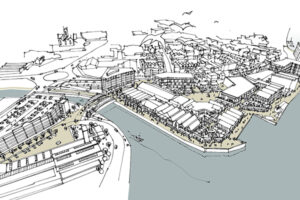By Rainer Kundörfer
In this contribution, I want to focus on the operators and owners. In most saturated markets, shopping center cornerstones are occupied by super-regional or mega-malls. They form the backbone of a comprehensive supply system for consumers in all the relevant segments: from fashion, leisure, and entertainment. The opposite pole is now formed by a thickening, market-spanning web of local shopping spaces in standalone locations or agglomerations like retail parks.
First generation shopping centers and district centers are increasingly at risk of being crushed in the middle. Objects in this property class were once the hotspots of their catchment areas, but they are now increasingly in danger of being pushed out of the market. In addition to competition from new trading locations, poor management, outdated architecture or technology, a lack of customer amenities, and aging retail concepts can all push these formats into the abyss.
The challenge for owners and operators
At the first sign of problems like vacancies, owners and operators usually reach for their phones to instruct their brokers to rent the vacancy. An architect may also come into play because some fresh paint should do the trick to get back into the game. This is well-meaning, capital conserving activism, but it is unfortunately not enough to survive. We’ve seen this type of reflex many times, only to find that treating the symptoms cannot secure a long-term investment return.
Using a structured approach to try to develop a solution together with the owner ends with a dynamic development process, whose ups and downs require one thing: courage and vision on the part of the owner. Private operators have one advantage over institutional ones here: They can make decisions more quickly and, as they are in direct contact, generally implement changes immediately. As long as they are equipped with the appropriate financial background or a straightforward financing structure is available, the projects can be handled stringently and rapidly. The deciding feature, however, is the ability of the owner to assess the situation quickly and clearly. Many of those responsible fail at this stage by overestimating their own property and underestimating impending dangers.
After an initial analysis of the situation, the retail property requires clear positioning and differentiation. The project manager must take the necessary measures in an open and creative process on an equal footing with his/her consultants and employees, together with the architect, the site engineer, marketing agents, and the center management. This is a very demanding process, especially when involving the vital interests of the active retailers. They will later be central beneficiaries of the refurbishment, but during the transformation process, they will also be affected negatively by lost revenue during conversion and/or relocation.
This is a really tough task even with smaller units. Real entrepreneurship is required. We hope to see more courage on the side of owners in the future in order to polish up the many hidden and slumbering rough diamonds out there. After all, why shouldn’t we offer our customers proven products while also offering a modern shopping experience in new splendor even as we conserve resources? They will thank us.
What is your opinion on this topic? Discuss it with us! Send your opinion to opinion@across-magazine.com !






